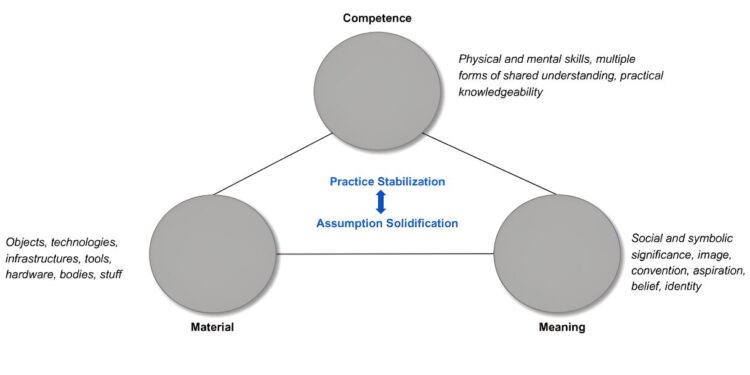Elements of social practices. Sociotechnical practices, like motion capture, inherit assumptions built into their elements, including prior versions of those elements. The assumptions that give rise to the practice in the first place also propagate through the combination and recombination of these elements. As practices evolve and stabilize, the assumptions behind them solidify. Credit: arXiv (2024).
Motion capture technology has applications in a wide range of fields, including entertainment, medicine, and sports, to name a few. But what if the measurements these systems were based on were rooted in social practices and biased assumptions, leading to errors that become entrenched over time?
This question is at the heart of new research co-authored by Mona Sloane, assistant professor of data science and media studies at the University of Virginia. The work is published on the arXiv preprint server.
Sloane and her co-authors: Abigal Jacobs, assistant professor of information at the University of Michigan; Emanuel Moss, research scientist at Intel Labs; Emma Harvey, doctoral student at Cornell’s School of Information Science; and Hauke Sandhaus, a doctoral student at Cornell Tech, use social practice theory as a lens to examine how certain assumptions have been embedded in the design and innovation of motion capture technology over the decades.
Social practice theory, the article explains, examines behaviors that can be observed in communities at different time periods, rather than focusing narrowly on an object or individual as a unit of inquiry. This approach allows researchers to uncover the assumptions built into technological systems, which can potentially reveal the harm these systems might cause.
Sloane and colleagues conducted a systematic literature review of 278 articles relating to motion capture research. They divide this literature into three eras: Foundation, 1930-79; Standardization, 1980-99; and Innovation, 2000 to present.
Within these three eras, the authors identify six types of errors that they believe provide essential insights into motion capture practices across the different periods.
For example, in the early era – where work focused on measuring the human body, which helped lay the foundation for motion capture technology – the analysis cited a study aimed at identifying the ideal design of a cockpit. To do this, the study author used body segment parameters from eight older white male cadavers, and the resulting measurements quickly became the accepted benchmarks for the US Air Force.
Errors in measuring the human body, or anthropometric errors, were common during the Founding era, the authors note. In more recent times, errors related to the algorithms used to analyze data are widespread.
Categorizing and understanding the implications of these errors, as well as the assumptions on which they are based, could have a profound impact on technology and society, the authors say. For example, automobile safety devices implemented based on crash test dummies designed to resemble an average male body have resulted in higher injury rates among women. This is just one example of insufficient subgroup validity testing leading to the harmful results highlighted by the article.
Through their analysis, Sloane and his co-authors develop a model for future research into social practices in technology design and use and also shed light on the poor foundations on which modern motion capture systems have sometimes been built. been built. Their findings highlight the many ways in which hypotheses have spread across different historical eras, becoming part of the infrastructure of some modern technological systems.
This research is part of a larger project that Sloane is leading with Jacobs and Moss on developing artificial intelligence auditing techniques for hardware- and sensor-driven systems. This paper was in the top 1% of more than 3,000 papers accepted by the Association of Computing Machinery’s CHI 2024 conference.
Sloane joined the UVA faculty in fall 2023. She holds a dual appointment in the University’s School of Data Science and the Department of Media Studies.
At UVA, Sloane directs the Sloane Lab, which conducts empirical research on the implications of technology for the organization of social life. The focus is on AI as a social phenomenon that intersects with broader cultural, economic, material, and political conditions. The Lab is at the forefront of social science leadership in applied work on responsible AI, public scholarship, and technology policy.
More information:
Emma Harvey et al, The corpse in the machine: social practices of measurement and validation in motion capture technology, arXiv (2024). arxiv.org/abs/2401.10877v1
Journal information:
arXiv
Provided by University of Virginia
Quote: New research examines how assumptions affect motion capture technology (January 22, 2024) retrieved January 22, 2024 from
This document is subject to copyright. Apart from fair use for private study or research purposes, no part may be reproduced without written permission. The content is provided for information only.



